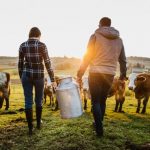
Average dairy co-op payout for Fonterra and Tatua farmers right up there with the best.
Total dairy cow numbers in New Zealand have continued their downward trend, falling 3.5% to 4.67 million in the 2022-23 season.
However, milk production remained relatively stable with 20.7 billion litres of milk containing 1.87bn L of milk solids processed by dairy companies, the annual NZ Dairy Statistics report released by DairyNZ and LIC showed.
This represented a 0.4% decrease in litres produced, but a 0.3% kgMS increase.
There were 10,601 herds for the season – 195 fewer than the previous season. The national average herd size fell by eight cows to 441.
The 2022-2023 season saw the average herd size increase in the North Island and decrease in the South Island.
In the South Island, North Canterbury has the largest average herd size at 792 cows. In the North Island, Hawke’s Bay has the largest average herd size, 660 cows.
The smallest average herd sizes remain in Auckland, Taranaki and Northland, averaging 283, 301 and 328 cows, respectively.
North and South Canterbury have the highest average cows per hectare of 3.47 and 3.26 respectively, both of which are marginal reductions relative to the previous season.
In terms of ownership structures, 56% (5959) of New Zealand dairy herds operate under owner-operators, 29% (3100) operate under a sharemilking agreement and 13.5% operate under a contract milkers agreement. Fifty-seven percent (1778) of all sharemilkers have 50/50 agreements.
The season saw an increase in the percentage of cows herd tested, at 81.1% (3.79 million cows, the highest percentage on record) while artificial breeding remained relatively stable at 3.81 million cows (82% of cows).
LIC chief executive David Chin said the increase in individual cow milk production and uptake of herd improvement services demonstrates farmers’ sharpened focus on cow efficiency.
“Our sector is producing more milksolids from a smaller cow population, and this is testament to the great work of Kiwi dairy farmers.
“Despite a challenging season, farmers have continued to invest in solutions that support them to produce the most sustainable and efficient animals for their herd.
“The use of high genetic merit sires and record number of cows being herd tested is enabling farmers to breed highly efficient cows that produce more and have a lower emissions intensity profile.”
The average dairy co-operative payout (including dividends) from Fonterra and Tatua was $9.26 for the 2022-23 season, which is the second-highest inflation adjusted payout for farmers on record.
DairyNZ chief executive Campbell Parker said farmers have done well to manage conditions, including Cyclone Gabrielle and high on-farm costs, and the varying impacts these had on farm operations.
“New Zealand dairy farmers continue to focus on using technology information to milk efficiently, while managing their individual farm conditions.
“These insights are driving better decisions, while a range of tools help improve herd sustainability and productivity.”
Parker said that dairy plays a large role in contributing to GDP and supporting the prosperity of local communities, as well as providing around 55,000 jobs nationwide.
“While managing climatic conditions, dairy export revenue is expected to increase to $25.1 billion in for the 2022/23 season.
“We should all be proud of the dedication of the dairy sector and what is achieved even in difficult seasons as we continue to deliver economic growth for New Zealand.”























